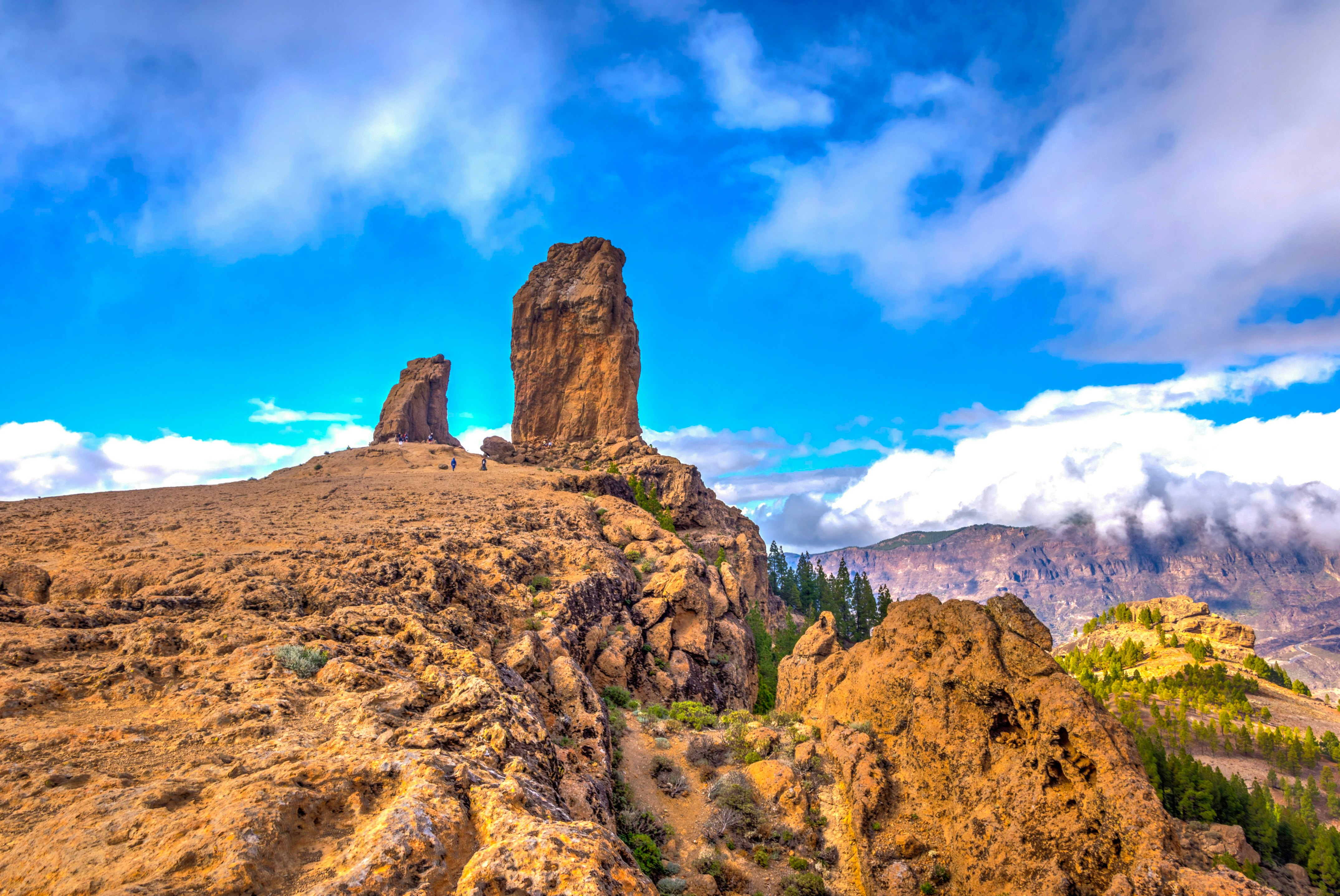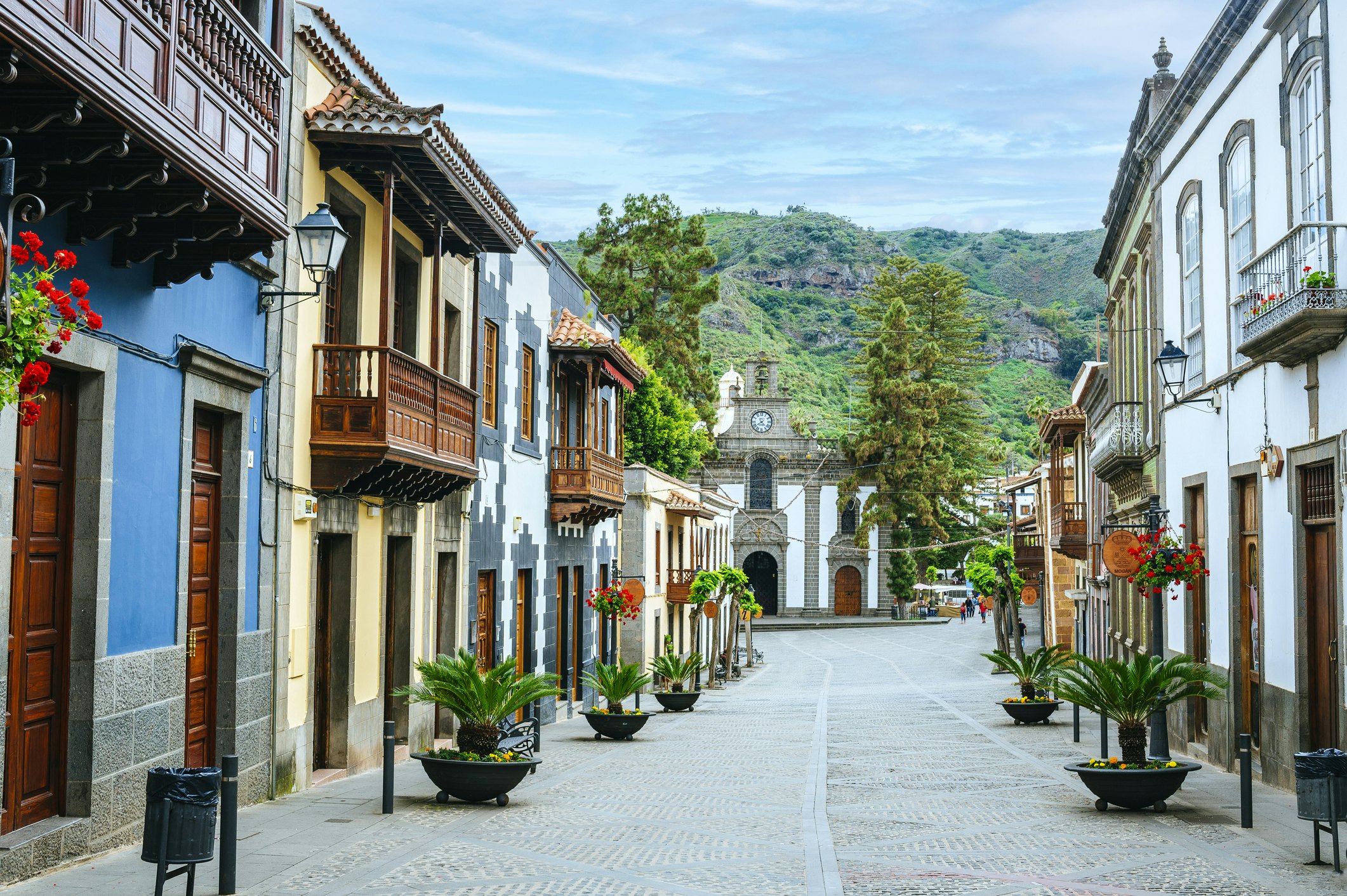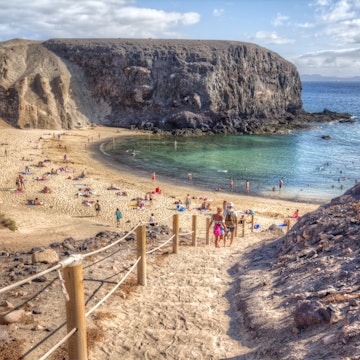

Gran Canaria. Maremagnum/Getty Images
When you fly into Gran Canaria or traverse its coastline by boat to dock at one of its ports, you instantly understand why this island has captivated and intrigued people for centuries.
It’s been given the nickname of "the continent in miniature" due to its diverse terrain, and "the land of eternal spring" for its climate. The original inhabitants, before the Spanish, named it "Tamaran," and their legacy can be seen across the island in remains of their cave dwellings and artefacts.
Gran Canaria is the middle child of the archipelago, having sprung up from the ocean floor about 14 million years ago. It is often compared to its neighbor, Tenerife, but each of the islands has its own merits.
Most people will know Gran Canaria for its beaches and resorts, particularly Maspalomas in the south, which encompasses the popular spot of Playa del Inglés. And while the beaches and sunny weather are spectacular, there’s much more to this beautiful island than sand, sun and sea, from incredible history and culture, magnificent sights and natural wonders, to outstanding food and wine.
When should I go to Gran Canaria?
For many years, Las Palmas de Gran Canaria held the title for the city with the best climate in the world. This is because the capital enjoys a temperate year-round climate with little rain and rarely scorching temperatures. Interestingly, Gran Canaria has its own microclimate, meaning that it can have hot, dry, sunny weather in the arid south, chilly, crisp and fresh temperatures in its mountainous center, and humid, hazy vibes in the north.
Gran Canaria is incredibly popular for winter sun, and beaches can be busy with tourists even in January – although you’re unlikely to spot a Canarian sunbathing until after April. Winter also plays host to several celebrations, including one of the world’s largest carnivals in February. These more-than-week-long celebrations take over the whole island and there are parties, parades and plenty of costumes and fun.
Summer also gets busy when the mercury can hit 30°C. However, with more than 60km of beaches around the island’s coast, you can usually find a spot on the sand to soak up some rays. Autumn and spring can be good times to visit, and prices tend to be a little lower, places less busy and temperatures ideal for exploring and sightseeing.

How much time should I spend in Gran Canaria?
Gran Canaria is both ideal for an exciting city break over a long weekend, a week-long beach holiday or an extended stay. In fact, it’s one of the most popular places for remote workers looking to balance work with the laid-back island lifestyle.
If you’re here for a week, you’re probably going to want to hit the beach (and I can’t blame you). While the dunes of Maspalomas are a sight to behold, try one of the quieter beaches such as Melenara near Telde or the remote Playa Guigui – it’s a bit of a hike but well worth it for unspoilt sand and an all-over tan if that’s your thing! Once you’re suitably bronzed, consider hiring a car and visiting the center of the island. You’ll find fragrant and fire-resistant Canarian pine trees, family-run vineyards and soaring volcanic monoliths such as Roque Bentayga, which were worshipped by the island’s original pre-Hispanic inhabitants.
If you’re hopping off a cruise ship or here for a city break, the capital city of Las Palmas de Gran Canaria – to give it its full name – is Spain’s eighth largest city and exudes a cool cosmopolitan vibe. It’s incredibly foodie and it’s worth indulging in the restaurant scene, from cool Canarian dishes by the beach in Mar Gastrotasca, to fine dining at Muxgo – the island’s first Green Michelin Star restaurant. Don’t miss the beautiful Las Canteras beach with its natural barrier reef that protects the shore and makes the seawater almost swimming-pool like. The old town of Vegueta and Triana is also worth a visit to wander the historic streets and museums.
Is it easy to get in and around Gran Canaria?
The island has one major airport, Gran Canaria Airport (LPA), located about halfway down the east coast, which covers both international and domestic flights. It’s easy to get from the airport to all major resorts by bus, taxi or hire car.
The bus network is extensive and reaches all parts of the island. Buses are inexpensive and reliable and run by Guaguas Global. In the capital, you’ll see yellow buses. These run the length and breadth of the city and are operated by Guaguas Municipales. Single journeys start at €1.40.
Car hire is a great way to explore the island. Prices are generally good value although can peak during busy periods so it’s advisable to book ahead. Try using a local company if you can such as Cicar or Tirma. You could easily drive the circumference of the island in a single day, it is so compact, but it’s worth taking your time and planning journeys in advance so you don’t miss anything. Make sure to fill up with fuel before heading inland, as the steep, winding mountain roads can deplete reserves quicker than you think.
From the ports in Las Palmas and Agaete, you can catch ferries and high-speed catamarans to neighboring islands including Tenerife.

3 of the best things to do in Gran Canaria
1. See the waves of sand
The rolling, shapeshifting, undulating dunes of Maspalomas should be on anyone’s must-visit list. These mountains of golden sand were here long before any development started in the resorts that now surround the protected space. Over the last few years, the Canarian government has brought in strict regulations for the dunes in order to preserve and protect them. There are several dedicated routes that you can walk that’ll take you to various parts including oases and La Charca nature reserve, a home to migratory birds. For your own bird's-eye views, head to the panoramic Atelier Cocktail Bar on the top of the Bohemia Suites hotel.

2. Climb the the Roques
There are two very famous monoliths in the center of the island, both of which are worth a visit. The Roque Nublo is the more famous, standing at a height of 80m and soaring nearly 2000m above sea level. The trek to the rock is relatively easy and takes about 30–40 minutes.
Alternatively, try climbing to the Roque Bentayga. This was the last point of defence for the island’s original inhabitants, and it’s easy to see why as it stands on a plinth with views of the surrounding sunken volcanic crater. Check out the ground at the top, there are carvings and holes in the stone that are still a mystery to historians.

3. Wander the old town of Las Palmas
No visit to the city of Las Palmas de Gran Canaria is complete without a stroll around the beautiful historic streets of Vegueta. Take a trip up the bell towers of the imposing Catedral Metropolitana de Santa Ana de Canarias to get views over the city, sea and surrounding rooftops. Nearby, stop at the Museo Canario to learn all about the island’s original inhabitants and visit the rather creepy skeleton room containing many real examples of their mummified and skeletal remains. Finish with a visit to Terraza Belvédère to enjoy a local wine on the rooftop overlooking the Santa Ana Square.

My favorite thing to do in Gran Canaria
I’m a sucker for a good market, and in Gran Canaria you’re spoilt for choice, from craft and artisan pop-ups to food and agriculture. One of my favorites, which I used to go to regularly when I lived in Las Palmas, is the weekend market in Vega de San Mateo. There are two giant warehouses that are full to the brim with stall holders. One is for crafts, but the other (which is my favorite) is the agricultural one. I love nosing at the stalls and chatting to the stallholders who often give you a little taste of their baked goods or let you sniff spices. There is usually a stall selling truchas de batata – sweet potato pasties – that I devour in an instant. It’s also a good place to pick up non-touristy souvenirs such as seeds, herbs and sauces.
My other favorite is the weekend market at Teror. This town is famous for two things: the church dedicated to the island’s patron saint, Virgen del Pino; and chorizo de Teror, a sort of spreadable chorizo paste. You’ll find countless stalls selling bocadillos (rolls as big as your head) slathered in chorizo de Teror and fresh cheese.
How much money do I need for Gran Canaria?
Gran Canaria can be relatively cheap if you avoid the obvious tourist traps. The currency is the Euro (€) and most places take credit and debit cards. Over recent years, cash has been on a decline, but it’s worth carrying some Euros in case you need them, especially in less touristic and developed areas.
Hotel room: €60–300 per night
Self-catering apartment (including Airbnb): €80–150 per night
Bus ticket: €2.50
Coffee: €1.50
Tapas for two: €30–50
Beer/glass of wine: €3
Bottle of local wine: €15–30
Is this a family-friendly destination?
Canarian people adore children, and you’ll find families socialize together from grandparents to babies until all hours. And don’t be surprised if Canarios talk to your children before they speak to you – the island is extremely family friendly.
Is Gran Canaria good for gay travelers?
Gran Canaria is one of the most popular destinations for the LGBTQ+ community. The island and islanders are incredibly open, and it is a safe environment to be yourself. Each year there is a famous Winter Pride in Playa del Inglés, centered around the Yumbo Centrum – the world’s only LGBTQ+ shopping center – where you’ll find bars, shops, restaurants and clubs.
What is the calima?
Some days in Gran Canaria, you might find that the air is very hot and yet it’s foggy or misty. This is known as the calima – the hot winds that blow over from the nearby Sahara Desert carrying sand dust in the air. While it won’t hurt you, it can make temperatures and being outside unpleasant.
















